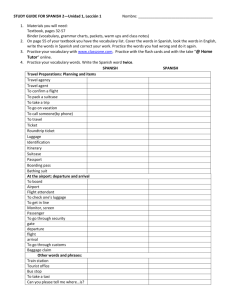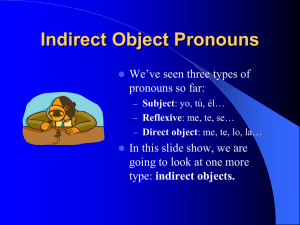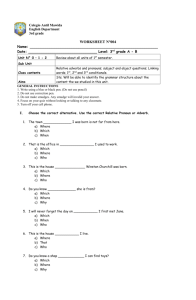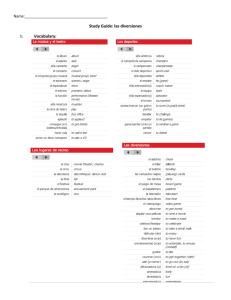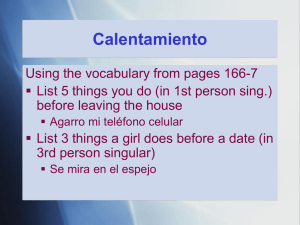Double Object Pronouns
advertisement
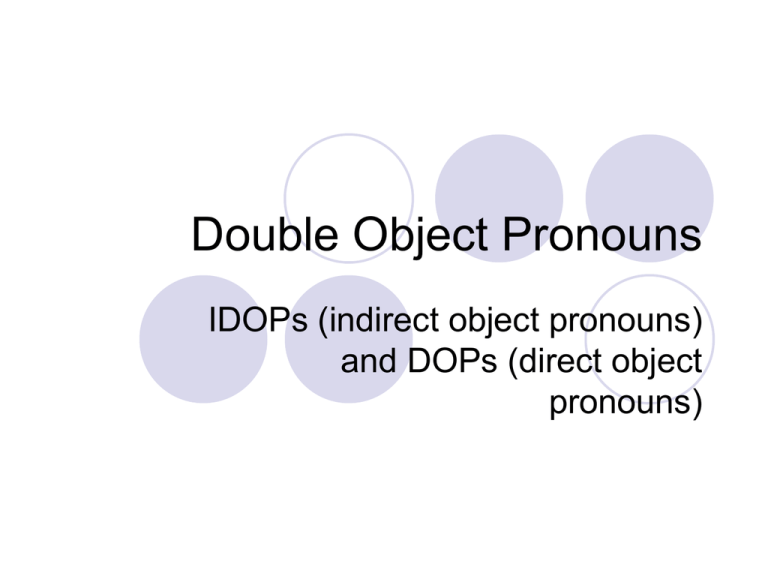
Double Object Pronouns IDOPs (indirect object pronouns) and DOPs (direct object pronouns) Reglas Some verbs can have a direct object and an indirect object Always use an IDOP when there is an indirect object La mesera nos trajo (a Juan y a mí) el pollo asado. ¡Vamos a practicar! [Recipient: you] ¿ ___ enviaron tus padres dinero también? ¿ Te enviaron tus padres dinero también? What if there is more than one of “you” ? ¿ Les enviaron sus padres dinero también? Use the “Uds.” form! Double trouble. In all of the examples, there are two objects. That is, someone is giving something to someone. The something is the direct object and the someone (the recipient) is the indirect object). Say what? Look at the examples and identify the objects: The teacher gave you an A. – Recipient: you – Thing received: an A Bill Gates sent me a million dollars. – Recipient: me – Thing received: a million dollars My parents bought my little sister a used car. – Recipient: my little sister – Thing received: a used car Spanish direct and indirect object pronouns may be used together in the same sentence just as in English. As with most all pronoun use, the objective is to reduce the length, complexity, or redundancy of the language. Julián, ¿me traes la película? Julián, will you bring me the movie? IOP DOP Te la traigo en un momento. I’ll bring it to you in a moment. As with all object pronouns, double object pronouns are placed before a conjugated verb, and the indirect object pronoun (IOP) precedes the direct object pronoun (DOP). Double objects We can simplify each sentence if we already know what the objects refer to. Look at this passage: My little sister got a new apartment across town, but there is no bus service. She saw a used car she liked a lot, but she didn’t have a lot of money. My parents bought it for her. Let’s take a closer look: My parents bought it for her. The expression in red is the indirect object (the recipient) and the word in yellow is the direct object. Both are pronouns. What about in Spanish? We can do the same thing in Spanish: Tengo que comprar un libro para la clase de historia, pero no tengo dinero. Mis padres me lo van a enviar por Western Union. – Recipient: me – Thing received: lo (el dinero) se lo, se la, se los, se las I threw it thetoball you.to you. Yo te lo tiré el. balón. You threw it thetoball me.to me. Tú me lo tiraste el. balón. Le and les must change to se before lo, la, los or las. I threw it thetoball him.to him. Yo se le lo tiré el. balón. You can’t “le lo” in Spanish! The context of the situation or the previous statement or question will clarify the meaning of se. Notice the following slide. L+L=S+L No, it’s not algebra class! There is a special rule about double object pronouns that you will need to know: if a sentence has two objects that both start with L, the first one changes to SE. se lo, se la, se los, se las ¿Le prestas el dinero a Lupita? Will you lend Lupita the money? No, no se lo presto. Es mucho dinero. No, I won’t lend it to her. It’s a lot of money. Queremos comprarles los juguetes a los niños, ¿no? We want to buy the toys for the children, right? Sí, vamos a comprárselos mañana. Yes, we’ll buy them for them tomorrow. I do! Mis padres me lo van a enviar por Western Union. Note that the indirect object precedes the direct object. Think “indirect, direct object”: I DO. The combinations of object pronouns in Spanish are as follows: me lo, me la me los, me las nos lo, nos la nos los, nos las te lo, te la te los, te las os lo, os la os los, os las se lo, se la se lo, se la se los, se las se los, se las Reglas When using DOPs and IDOPs, the order is… IDOP + DOP…always Remember “I DO” or…. “123 IDV” 2 L’s = 1st changes to SE ¿Le dejaste la propina a la mesera? Sí, ya se la dejé. Práctica She asked her for them. (strawberries). Ella se las pidió. We served you it. (steak with onions). Nosotros te lo servimos. I recommend them to you all. (tea and flan). Yo se los recomiendo. ¡Ya está! To summarize, here are the four forms you will need: Subject yo tú él ella Ud. nosotros ellos ellas Reflexive me te se se se nos se se Direct object me te lo la lo, la nos los las Indirect object me te le le le nos les les

